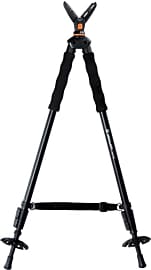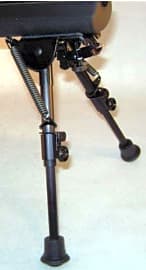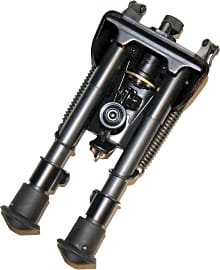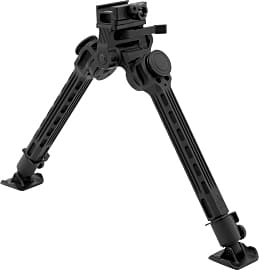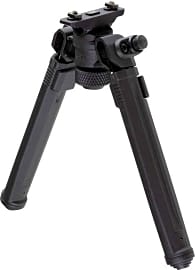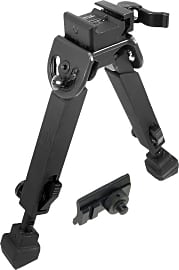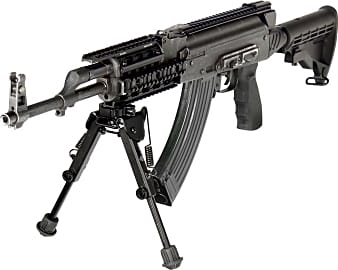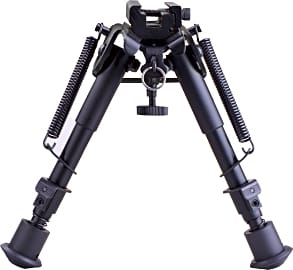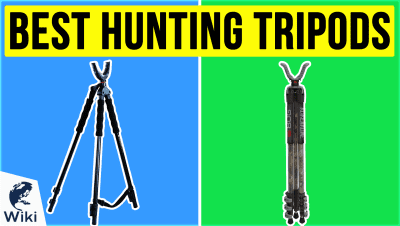The 10 Best Rifle Bipods

This wiki has been updated 39 times since it was first published in April of 2015. If you want to ensure your shots are accurate when at the target range or out hunting, you may need a stable platform on which to rest your weapon. That's where these rifle bipods and shooting sticks can help. They will let you set up on a variety of terrains, and come with varying adjustable height capabilities. They're ranked by durability, ease of use, versatility, and price. When users buy our independently chosen editorial recommendations, we may earn commissions to help fund the Wiki.
Editor's Notes
May 28, 2021:
Just a few minor updates to bring to your attention here. The Vanguard Quest T62U was moved up do its class-leading versatility, although the AccuShot BT10 Atlas is still our overall favorite due to its premium construction. If you like the style of the AccuShot but don't want to spend that much, consider the similar Magpul MMAGBP. We also added the upgraded versions of the UTG TL-BP99Q and Primos Gen3 Trigger Stick, which are both high-performing units although they aren't the most portable. The UTG is pretty heavy and the Primos doesn't retract much. For casual shooters or those on a tight budget, the CVLife Tactical 6-9 is worth a look although it isn't the most stable and can have a bit of a rattle.
January 11, 2020:
When it comes to precision long-range shooting, a sturdy rifle bipod is a must-have accessory. They provide a lot more stability than shooting off-hand, which means you should be able to get more rounds in the target, and attach directly to your firearm, so you won't have any additional gear to lug around.
One of the most important considerations when choosing a bipod is the caliber of your weapon. It is vital that your bipod of choice matches the caliber of your gun. For example, if shooting a large-caliber rifle, you'll want something very robust that can stand up to the heavy recoil, such as the UTG Big Bore TL-BPFS01 or AccuShot BT10 Atlas. On the other hand, if shooting a small .22-caliber firearm, you can get by with a less sturdy unit like the CVLife Tactical 6-9.
Expected shooting position must be considered as well. If you do most of your shooting from a seated or kneeling position, with the bipod legs set on the ground, but want the ability to set up for prone shooting periodically, you'll want something like the Harris BiPod Solid Base 1A2-25C in the 13.5 to 27-inch model, since this will prop your weapon up high enough for comfortable use. If you prefer the ability to stand or kneel, you'll want to look at the Vanguard Quest T62U or Primos Gen 2 Trigger Stick. Just be aware that longer models like these will be more cumbersome to carry. We also recommend considering a hunting tripod if you generally prefer to stand while shooting, as their triple-leg design will often offer more stability than very tall bipods.
When it comes to value for money, any seasoned hunter or tactical shooter will tell you that three companies tend to stand head and shoulders above the rest: Harris Engineering, UTG, and Magpul. Because of this, it should be no surprise that bipods from these three manufacturers make up half of our list. The Harris BiPod Solid Base LM-1A2, Harris Engineering S-BRM, UTG Big Bore TL-BPFS01, Magpul MMAGBP, UTG TL-BP20Q-A, and UTG TL-BP88Q can all stand up to rough use in the field day after day, offer rust-resistant construction, and utilize heavy-duty hardware to ensure the legs never slip when shooting.
Special Honors
Elite Iron Revolution The Revolution, which is designed for .375-, .408- and .338-caliber rifles, features cold-rolled steel leg locks to ensure it never slips out of position during use, and boasts a hidden-spring design, reducing the chance of it getting caught on anything when in the field. Conveniently, it allows the firearm to rotate a full 360 degrees, too. eliteiron.com
MDT Ckye-Pod The MDT Ckye bipod offers simple one-handed adjustments, three front-to-back locking positions, and a 4.5 to 15.5 inch height range. It also boasts 170 degrees of cant and 360 degrees of pan capability, making it easy for to hunters to get on target, and stay there as their prey moves. mdttac.com
Selecting The Right Rifle Bipod
And if you want to take well aimed rifle shots while standing up, there are bipods for that arrangement too.
A rifle bipod is one of the simplest ways for a shooter to establish a stable, reliable shooting platform anywhere and any time. In the absence of a dedicated shooting table, a bipod is the next best way to ensure accurate and consistent shots. Rifle bipods provide the stability a shooter needs to establish a proper sight picture and to minimize the slight movement that even a steady arm can generate when holding a weapon freely. After all, even a mere millimeter of shift in barrel position can result in a shot going meters off target if the range is great enough.
Choosing the right rifle bipod for your needs first means consider your standard shooting position. If you like to take your shots while lying prone (or if your work is of a tactical nature and necessitates this shooting position) or from a table with the aid of a compact bipod, then there are many options available that will suffice for myriad types of long gun.
If you prefer to do your shooting from a seated position without an additional table or platform, as is common with many game hunters and with sport and target shooters, then there are also plenty of bipods that can accommodate this setup. And if you want to take well aimed rifle shots while standing up, there are bipods for that arrangement too.
There are even a few rifle bipods available which allow for both seated and standing shots, but there are not many options that can be used prone or seated/standing without additional hardware, such as a shooting table. The best approach is to look for a bipod that will best serve your primary needs rather than looking for a unit that can serve in multiple capacities.
If you will be setting up your bipod in the woodlands or on constantly uneven surfaces, such as in dilapidated urban areas, make sure to select a unit that allows for easy independent adjustment of each leg. Some bipods allow for a wide range of adjustment, while others offer only a few inches of extension. The more extension allowed, the easier you can set up a level shooting platform, but know that the more the kegs are extended, the less stable that platform might be.
On Taking The Perfect Shot
The first thing you must learn is how to properly hold your rifle. This means a steady, firm hold on both the fore stock and the handle or crook, depending on rifle model, with the trigger resting between the tip and first knuckle of your forefinger. The weapon's stock should be secure against the muscle just below your shoulder at the upper, outer region of the chest. Your cheek should rest firmly against the butt of the rifle. When held properly, even a powerful rifle's recoil will be absorbed by your body and will not "punch" or jump uncomfortably.
The weapon's stock should be secure against the muscle just below your shoulder at the upper, outer region of the chest.
Steady, consistent breathing is one of the most important skills a shooter must master. You should line up your shot and pull the trigger home while in a respiratory pause or else while very slowly, very steadily exhaling. Inhaling causes too much body movement, and holding your breath for too long can be uncomfortable.
The actual act of pulling the trigger is where most shooters lose their sight picture and take an inaccurate shot. The tendency of the inexperienced shooter is to rapidly pull the trigger home rather than steadily applying pressure until the moment the shot takes place.
One good way to reduce the erratic motions that can be caused by the anticipation of a loud shot is to practice holding the trigger back until well after the shot, rather than always releasing it as soon as the bullet takes flight. By conditioning yourself to pull the trigger "through" the shot and holding it after the release, you will minimize your hand movement in the split seconds before the weapon's noisy report. This is often referred to as trigger follow through.
As far as improving your actual aim, that requires a knowledge of your sights and a commitment to practice. Know the proper use of iron sights and practice their alignment, or take the time to make sure your scope is mounted properly and zeroed in. Once you know how to use your rifle's sights, you can practice actually using them, and then you can begin to master factors such as bullet drop, the Coriolis Effect, and more.
A Brief History Of The Bipod
The word bipod is derived from both Greek and Latin roots. Bi, from the Greek, simply means two; pod comes from Latin and refers to feet. This simple device has been in use since the earliest days of individually operate firearms, from the days of the Chinese fire lance, first devised in the 13th Century.
This simple device has been in use since the earliest days of individually operate firearms, from the days of the Chinese fire lance, first devised in the 13th Century.
Many of the first true firearms, such as early arquebuses, were too heavy and cumbersome to be fired without the aid of a stabilizing device. Simple monopods of the 15th and 16th Centuries often consisted of little more than sticks or staves of wood cut to an appropriate height and topped with a crook of wood. A musketeer would set up his weapon atop a monopod while aiming and firing, but would need to lower it between each shot for the purpose of reloading.
Bipods can hold a weapon more stably than a monopod as they create an effective tripod using the shooter's body as the third point of stabilization. This allows for easy maintaining of the sight picture and greater accuracy over a series of plural shots. The bipod as it is known today is largely modeled after a device patented by Captain John Butler in 1921.


